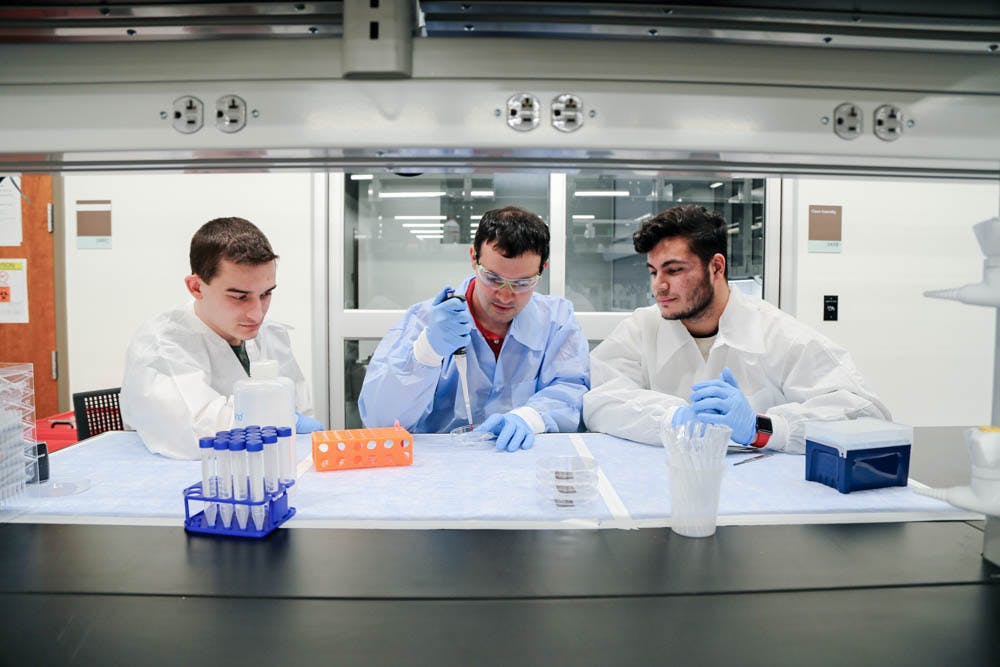University researchers recently published a study analyzing the material properties of alginate graphene oxide, which could lead to new developments in both cancer research and 3D printing technology for human organ printing.
The team aims to simulate the environment in which tumors grow and use that simulation to predict the response of human cells to tumor growth.“There’s (an) ongoing hypothesis that if you make (a cell) matrix that’s disregulated and stiffer … (it may) also support more aggressive tumor cells,” said Ian Wong, assistant professor of molecular pharmacology, physiology, biotechnology and engineering, who oversaw the study.
The adjustable stiffness of alginate GO allows researchers to examine how changes in stiffness affect cell behavior, he added. In addition, the discovery of alginate GO’s properties could potentially be used to develop cancer immunotherapies, improve drug delivery and aid in tissue engineering.
The study found that by adding a certain amount of GO to alginate gel, a jello-like substrate, a firmer gel is produced; this new gel can be used in ways distinct from the uses of pure alginate gel. Thomas Valentin GS , the principal investigator of the study, described the experimental process. First, the team tested if the mixture could behave like a liquid, a property which is ideal for particular kinds of 3D printing. Second, the researchers evaluated the mixture’s ability to withstand various pressure and stress tests.
The team found that the alginate GO mixture is stronger and stiffer than just alginate, all while behaving in the liquid-like manner required of biomaterials used for 3D printing. Valentin worked closely with co-investigators Alex Landauer ScM ’16 GS, Luke Morales ’18 and other researchers based at the School of Engineering, University of Wisconsin and the National University of Singapore.
The researchers chose GO to add to the alginate because they knew it was “a material several orders of magnitude stiffer than alginate,” Valentin said. GO is unique because it is comprised of a sheet of “atomically thin carbon,” making it one of the strongest materials in the world.
The findings of this study build on Valentin’s previous work, which demonstrated that it was possible to 3D print using alginate through a process called stereolithography, whereby a laser beam passes over a vat of liquid and transforms selected liquid molecules into a solid shape.
Using the combination of stereolithography and alginate GO, scientists can now 3D print human organs with internal channels that mimic blood vessels in human tissues, a feat not previously possible using alginate alone because alginate is “too soft … and hard to handle,” Wong said.
3D-printed organ cells typically suffer from a short lifespan due to a lack of nutrient delivery to the center of the organ and its cells, which can lead to potential cell and organ death. Now that this new 3D printing technology allows for the printing of blood vessels throughout the organ, nutrient delivery to the centermost cells of the organ is possible, which increases the organ’s shelf life, Valentin said. These innovations will allow researchers to 3D print vascular (blood vessel) systems.
Moving forward, the next step for researchers will be to further optimize the material for other properties, which in turn could lead to additional applications. Two properties that are most exciting to researchers are oil repellency and anti-fouling behavior. “If we optimize these, we could have many applications for marine anti-fouling, (such as) sensors that can take readings during an oil spill,” Valentin said. One day, the oil repelling abilities of alginate GO could be used to prevent fouling by oils and corrosion by seawater, he added.
Although GO is commonly added to various compounds, including certain types of plastics, this is the first time it has been used in biomaterials for 3D printing, said Robert Hurt, professor of engineering and founding director of the University’s Institute for Molecular and Nanoscale Innovation, whose research concerns environmental and biological safety testing of new materials. “The use of (GO) for 3D printing is a very specific application. You could easily take this further. It’s not expensive or difficult,” he said.
Correction: An earlier version of this article stated that “scientists can now 3D print human organs with blood vessels.” In fact, scientists can now 3D print biomaterials with internal channels that mimic blood vessels in human tissues. Therefore, the headline “Researchers improve 3D printed biomaterials” is more accurate. The article also mistitled Ian Wong as associate professor of molecular pharmacology, physiology, biotechnology and engineering. In fact, he is assistant professor of molecular pharmacology, physiology, biotechnology and engineering. The Herald regrets the errors.





